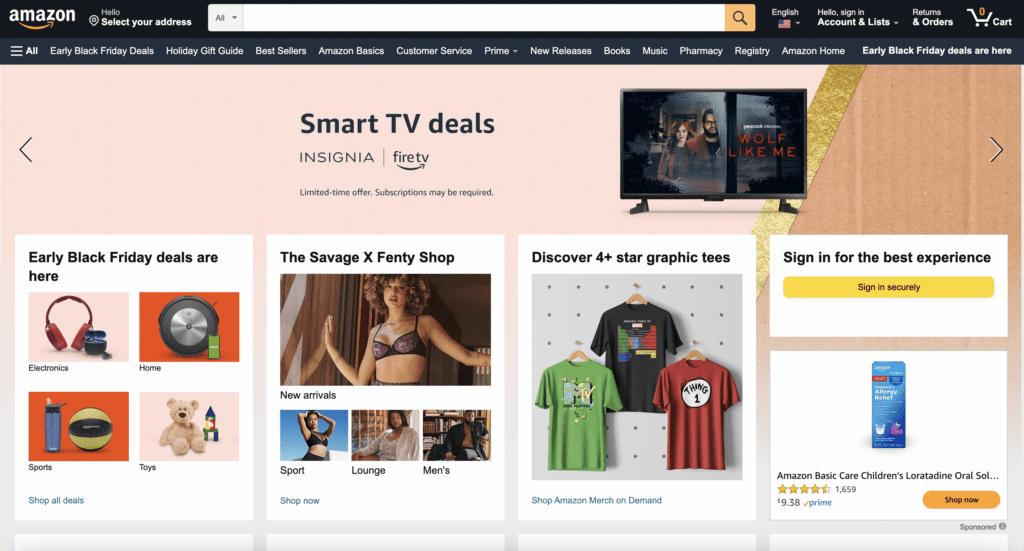
This page may contain affiliate links. Please read my disclosure for more information.
Did you know that in 2021, Amazon made over $469.82 billion in sales? And according to recent studies, that number is only going to continue to grow. In fact, it’s estimated that by the end of 2022, Amazon will be making a whopping $689 billion in sales. That’s a lot of money up for grabs!
So what does this mean for you? It means that if you’re looking to make some extra cash or start an Amazon storefront, then Amazon is the place to be. But with so much competition out there, how can you make sure your business stands out from the rest?
Well, that’s where this guide comes in. In it, I’ll teach you everything you need to know about how to make money on Amazon with your own Amazon Associates account. I’ll cover everything from setting up your account and choosing the right products to sell, to marketing your business and scaling up your operations. So whether you’re a complete beginner or an experienced entrepreneur looking for some new tips, this guide has something for you.
1. Find a Niche

This is the market you’ll be selling to, and it’s important to choose one that’s both profitable and not too saturated.
There are a few things to consider when choosing a niche:
- What are people buying?
- What are people not buying?
- What can you offer that others can’t?
- What are your interests?
To get started, sit down and brainstorm a list of potential niches. Consider what you’re passionate about, what kinds of products you’re interested in selling, and what gaps you see in the market that you could fill.
Some of the best niches are ones that solve a problem or fill a need that people have. For example, let’s say you’re passionate about fitness. You might choose to sell workout gear or healthy snacks.
Or maybe you’re into fashion. You could sell clothes, accessories, or beauty products. Once you have a list of potential niches, it’s time to do some research.
2. Research Your Niche

Now that you have a list of potential niches, it’s time to start doing some research. This will help you narrow down your list and choose the best niche for your business.
There are a few things you’ll want to consider when researching your niche:
- What is the demand for this product?
- Are there already a lot of businesses selling this product?
- Is this a seasonal or trendy product?
- What are the shipping costs?
- What are the manufacturing costs?
To get started, head over to Amazon and start browsing through the products in your niche. Pay attention to things like sales volume, reviews, and prices. This will give you a good idea of what’s selling well and what isn’t.
You can also use Google Trends to get an idea of whether a particular product is trending up or down. This is useful for seasonal products or those that might be impacted by current events.
3. Choose Your Products Wisely

This may seem like a daunting task, but it’s actually not as difficult as it sounds. The key is to choose products that are in high demand and that have low competition.
To find products that fit this criterion, you can use Amazon’s search engine and look for things like “best sellers” and “hot new releases.” You can also check out sites like JungleScout, an Amazon Seller Software for product research. It offers detailed product insights that can help you make informed decisions about what to sell.
Another thing to consider is whether you want to sell physical or digital products. Physical products with retail arbitrage tend to be more popular on Amazon, but they also come with higher shipping and storage costs. Digital products, on the other hand, are often cheaper to produce and can be delivered instantly to customers on Kindle stores.
While there’s no right or wrong answer here, it’s important to choose products that you’re comfortable with shipping and storing.
Once you’ve found a few potential products, it’s time to start evaluating them.
- Look at the demand for the product. Is it something that people are actually searching for?
- Look at the competition. How many other Amazon sellers are offering the same product?
- Look at the price point. Can you sell the product for a competitive price?
- Look at the reviews. What are people saying about the product?
By taking the time to evaluate your products, you can make sure you’re choosing items that are both in high demand and have low competition. This is the recipe for success on Amazon!
4. Find a Supplier

This can be done in a few different ways. You can find a local supplier, an online supplier, or even a dropshipper.
- Local Suppliers: If you have a local business, you may be able to find a local supplier. Many times, these suppliers will give you a discount for being a local customer. To find a local supplier, you can search online or on the yellow pages. You can also ask other businesses if they know of any good suppliers.
- Online Suppliers: If you don’t have a local business, you can find an online supplier. There are many websites that sell products at wholesale prices. To find an online supplier, you can search the internet or ask other businesses for recommendations.
- Dropshippers: Dropshippers are businesses that sell products to customers on behalf of a retailer. Dropshippers will oftentimes sell products at a discounted price. You can find dropshippers by searching the internet or by asking other businesses for recommendations. Some of the more popular dropshipping websites are AliExpress and Alibaba.
5. Make a Selling Plan

This may sound like a no-brainer, but it’s actually more important than you might think. See, a lot of people make the mistake of starting an Amazon business without really knowing what they’re doing. They choose a product they think is popular and start selling it without any sort of plan or strategy.
Not only is this a recipe for disaster, but it’s also a surefire way to lose money. A selling plan will help you figure out exactly what you need to do in order to be successful on Amazon. It will also force you to think about things like your target market, your competition, and your long-term goals.
Without a selling plan, you’re really just shooting in the dark and hoping for the best. So, take the time to sit down and create a detailed plan for your Amazon business. You’ll be glad you did!
6. Consider Your Selling Strategy

Selling on Amazon can be a great way to make money, but you need to have a clear selling strategy in place before you get started. There are three main ways to sell on Amazon:
Sell as an individual
It’s easy to get started selling as an individual on Amazon. You just need to create an account and list your products. You’ll be responsible for shipping your products to customers and handling customer service yourself. For creative handmade sellers, you can sell wholesale goods on Amazon Handmade platform.
Under this selling model, you’ll be charged a $0.99 fee for each item you sell, plus a referral fee (varies by product category).
Sell as a professional seller
If you plan to sell more than 40 items per month on Amazon, you’ll need to sign up as a professional seller. As a professional seller, you’ll be charged $39.99 per month, plus a referral fee (varies by product category).
Sell through Amazon FBA
If you want to offload some of the work involved in selling on Amazon, you can use the Fulfillment by Amazon (FBA) program. With Amazon fulfillment center, Amazon will store your products in their warehouses and ship them with their own delivery service to customers for you. You’ll still be responsible for customer service, but you won’t have to worry about shipping.
FBA comes with a few extra fees, including storage fees and picking, packing, and shipping fees. But it can be worth it if you want to free up your time to focus on other aspects of your business.
When you’re considering which selling strategy to use on Amazon, think about your product, your budget, and the amount of time you’re willing to spend on shipping and customer service. If you’re just starting out, selling as an individual might be the best option. But if you’re looking to grow your business, you might want to consider using FBA.
Or, you can consider the Amazon associates program if you already have your blog running and want to affiliate with an Amazon affiliate program to earn commission on every sale you make from your site. And don’t ignore the Amazon Services option that helps you sell professional services, making Amazon a great online marketplace to make money.
7. Create your Amazon Seller Account

This is pretty straightforward and only takes a few minutes. Just go to Amazon’s website and click on “Create Your Amazon Account.”
Once you’ve done that, you’ll need to provide some basic information about yourself, including:
- Internationally chargeable credit card
- Tax information
- Phone number
- Government ID
- A bank account where Amazon can send you proceeds from your sales.
- Business email address or Amazon customer account
- An Amazon Professional Selling Plan subscription to list products in certain categories
Once you’ve completed all of the fields, click “Submit.”
You’ll then be taken to a page where you can select your selling plan. If you’re just starting out, choose the Individual plan. You can always upgrade to the Professional plan later if you need to.
8. Choose Your Pricing Strategy Carefully

When you’re setting the price for your product, it’s important to think about your overall pricing strategy. There are a few different pricing strategies you can use, and each has its own advantages and disadvantages. You’ll need to choose the right pricing strategy for your product and your business.
- Cost-plus pricing is when you add a markup to the cost of your product. This is the most common pricing strategy, and it’s often used by businesses that are just starting out. With cost-plus pricing, you’ll need to know your costs very well so that you can add a realistic markup. The advantage of cost-plus pricing is that it’s easy to calculate your prices. The disadvantage is that you may not be able to charge as much as you could with another pricing strategy.
- Competitive pricing is when you set your prices based on what your competitors are charging. This can be a good pricing strategy if you’re selling a product that’s similar to what your competitors are selling. With competitive pricing, you can be sure that you’re not overcharging or undercharging for your product. The disadvantage of competitive pricing is that you may not be able to charge as much as you could with another pricing strategy.
- Value-based pricing is when you set your prices based on the perceived value of your product. With value-based pricing, you’ll need to do some research to figure out how much your product is worth to your customers. The advantage of value-based pricing is that you can charge more for your product if it’s perceived as being worth more. The only drawback of value-based pricing is that it can be difficult to determine the perceived value of your product.
There are a few other pricing strategies you can use, but these are the most common. You’ll need to choose the right pricing strategy for your product and your business.
9. Create Your Listings

This is where you’ll need to provide all of the information about your product, including:
- Product Title
- Product Description
- Price
- Shipping costs
- Product images
You’ll also need to choose the right category for your product. Amazon has a huge range of categories, so you’ll need to do some research to figure out which one is right for your product.
Once you’ve created your listing, you’ll need to set up your shipping options. You can use Amazon’s Fulfillment by Amazon (FBA) service to have Amazon ship your products for you. Or you can ship your products yourself.
If you’re just starting out, you may want to use Amazon’s FBA service. This will save you a lot of time and hassle.
10. Use Amazon Sponsored Products

Amazon Sponsored Products is a great way to promote your products on Amazon. With Sponsored Products, you can create ads that will appear on Amazon.com when people search for keywords that are relevant to your products.
Creating a Sponsored Products ad is easy. You’ll just need to create a campaign, select your product, and set your bid. Your ad will then start appearing on Amazon.com.
11. Get Reviews for Your Products

One of the best ways to increase sales on Amazon is to get reviews for your products. Reviews can help increase your product’s visibility and make it more likely that people will buy it.
There are a few different ways to get reviews for your products. The best way is to offer incentives, such as discounts or free products, in exchange for reviews. You can also reach out to friends and family members to ask them to leave a review.
Final Thoughts
Making money on Amazon is a great way to start or grow your business. With over 2.4 billion visits, there’s a huge potential market for your products. Maybe selling a product doesn’t feel right to you? You can always learn how to make money on Amazon KDP without writing.
By following the steps in this guide, you can be well on your way to succeed on Amazon. Leave your comment below.
You may also enjoy reading How to Create an Amazon Storefront in 10 Easy Steps.







+ show Comments
- Hide Comments
add a comment